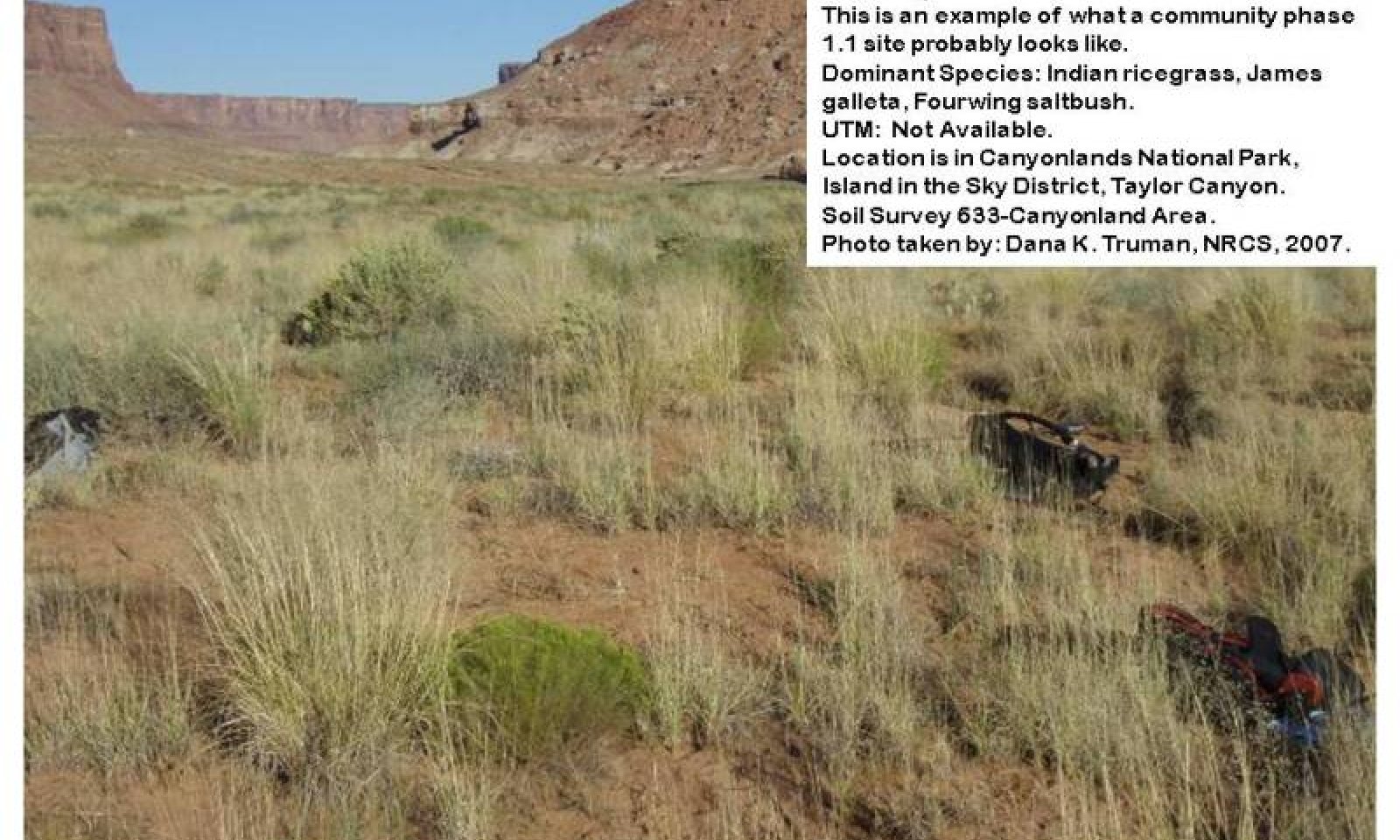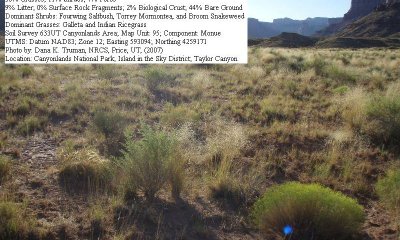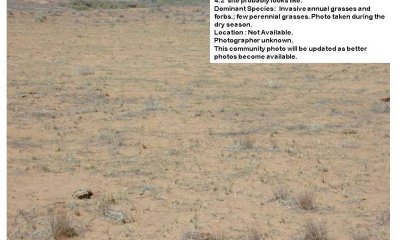
Desert Sandy Loam (Fourwing Saltbush)
Scenario model
Current ecosystem state
Select a state
Management practices/drivers
Select a transition or restoration pathway
- Transition T1a More details
- Transition T2a More details
- Transition T2b More details
- Restoration pathway R3a More details
- Transition T3a More details
-
No transition or restoration pathway between the selected states has been described
Target ecosystem state
Select a state
Description
This reference state was determined by the study of rangeland relic areas, areas protected from excessive disturbance, as well as areas influenced by activities such as grazing and recreation. Literature reviews, trends in plant community dynamics, and historical accounts are also considered.
This reference state represents the plant communities and ecological dynamics of the desert sandy loam, fourwing saltbush site. This state includes the biotic communities that can become established on this ecological site if all successional sequences are completed under the natural disturbance regime. This state is dominated by perennial warm and cool season grasses, where four-wing saltbush and mormontea species make up the dominant shrub canopy. In this state, both warm and cool season grass species are present, including Indian ricegrass and James galleta. Forb composition is variable.
Primary disturbance mechanisms include occasional fire caused by lightning strikes and Native American ignition sources, climate fluctuations, insect herbivory, and native herbivore grazing. Timing of these natural disturbances dictates the what ecological dynamics occur. The reference state is self sustaining and resistant to change due to its high resistance to natural disturbances and it's high resilience following natural disturbances. When natural disturbances occur, the rate of recovery is relatively rapid due to niches being filled with highly adapted native vegetation.
Reference State: Community phases influenced by infrequent fire, native herbivore grazing, insect herbivory, and weather.
Indicators: A well developed perennial cool and warm season grass understory with fourwing saltbush forming the dominant visual aspect.
Feedbacks: Extended drought and/or improper grazing that result in a reduction of native perennial plant vigor which may cause invasive species to become established in the understory, increased bare spaces, erosion, and soil loss. Infrequent but regular fires and/or properly managed grazing that maintain the perennial bunch grass understory and the establishment of shrubs.
At-risk Community Phase: All communities in this state are at risk when native plants are stressed and/or nutrients become available for invasive plants to establish; plant community 1.3 is most at risk due to its limited understory.
Trigger: Introduction and establishment of non-native invasive plants such as cheatgrass and Russian thistle.
Submodel
Description
This state is similar to the reference state except there are now non-native invasive plants established in the understory. This state is dominated by perennial warm and cool season grasses, where fourwing saltbush and various mormontea species make up the shrub canopy. Dominant grass species include Indian ricegrass and James galleta. Forb composition is variable. Primary disturbance mechanisms include fire, human induced fire suppression, weather fluctuations, domestic livestock grazing, insect herbivory, and native herbivore grazing. Timing and severity of these disturbances dictate the ecological dynamics that occur. Disturbances can lead to shifts in species composition that affect the nutrient cycling, soil-water relationships, hydrology, and soil stability. This state has lower resistance to disturbances and resilience after disturbance than the reference state due to the occurrence of invasive species and increased bare ground.
Current Potential State: Community phases influenced by fire, native herbivore grazing, domestic livestock grazing, insect herbivory cycles, lack of disturbances, and weather.
Indicators: A well developed perennial cool and warm season grass understory with fourwing saltbush forming the dominant visual aspect. Invasive plants are present.
Feedbacks: Extended drought and/or improper grazing that result in a reduction of native perennial plant vigor which may cause invasive species to dominate the understory, increased bare spaces, erosion, and soil loss. Infrequent but regular fires and/or properly managed grazing that maintain the perennial bunch grass understory and the establishment of shrubs.
At-risk Community Phase: All communities are at risk when cheatgrass is present in the understory due to increased fine fuels, which may decrease the natural fire return interval that could eventually lead the site into an annual grass state (State 4). All community phases are also subject to possible transition into the disturbed state (state 3) due to increased bare ground, and increased opportunities for soil erosion especially when site is exposed to improper livestock grazing.
Trigger: Increase and/or establishment of broom snakeweed, and surface disturbances which increase soil erosion and loss; and/or increased establishment of invasive annuals such as cheatgrass and annual mustards which decrease the fire return interval.
Restoration Pathway: None
Submodel
Description
This state is characterized by a dominance of broom snakeweed, Russian thistle, and various mormontea species, with minimal occurrence of the perennial warm and cool season grasses associated with this site. Fourwing saltbush may or may not be present. The primary disturbance mechanism is improperly managed domestic livestock grazing that maintains the broom snakeweed and bare ground. The shift in species composition, as well as the increased bare ground, affects the nutrient cycling, soil-water relationships, hydrology, and soil stability of this site. This state has lower resistance to disturbances and resilience after a disturbance than the previous two states.
Disturbed State: Community phase maintained by improperly managed domestic livestock grazing.
Indicators: A plant community dominated by broom snakeweed and Russian thistle, where bare ground is very common.
Feedbacks: Improper domestic livestock grazing that allows for the continued establishment and maintenance of broom snakeweed and bare ground. Time without disturbances that may aid in the reestablishment of native perennial grasses and shrubs.
At-risk Community Phase: All community phases are at risk when cheatgrass is present in the plant community and there are sufficient fine fuels to carry a fire.
Trigger: Increased cheatgrass and a resulting decrease in the sites fire return interval.
Restoration Pathway: Time with proper livestock grazing or other disturbance that allows native perennial vegetation to reclaim the site. This may take many years to accomplish.
Submodel
Description
This states ecological processes are driven by the dominance of cheatgrass production. Other invasive, and some native plant species may also be present. Cheatgrass dramatically affects the soil/plant/water relationships of a site. Research has shown that it has substantial effects on soil water content and temperature, as well as impacts on the frequency and intensity of disturbance. After a cheatgrass invasion, a sites fundamental nutrient cycling processes, root pores, mycorrhizal associations, microbial species, and soil organic material are changed (Chapin et al. 1997; Belnap and Phillips, 2001). These alterations may eventually create ecologically impoverished sites that are very difficult to restore to functionally. The competitiveness of cheatgrass and its ability to quickly establish after a disturbance make this state extremely resistance to change and resilient after a disturbance.
Annual Grass State: Community phases maintained, in a self-sustaining manner, by frequent fire.
Indicators: A site where ecological processes are driven by cheatgrass.
Feedbacks: A self sustaining disturbance
regime of frequent fire.
Submodel
Mechanism
This transition is from the native perennial grass understory in the reference state to a state that contains invasive plants such as cheatgrass, Russian thistle, and annual mustards. Events that may trigger this event include fire, improper domestic livestock grazing, and extended drought that stress the native plants and allow nutrients to become available for more tolerant invasive species. Non-native, invasive species such as cheatgrass, however, have been known to invade into intact perennial plant communities where little to no disturbances have occurred. So while this transition may occur from any state in the reference state it typically will occur from community 1.3. Once invasive species have established in the understory a threshold has been crossed.
Mechanism
This transition from the Current Potential State (State 2) to the Disturbed State (State 3). This transition occurs when events favor broom snakeweed to dominate the site. Bare ground increases and perennial/annual grass production decreases. Events typically include improperly managed domestic livestock grazing for extended periods of time. This transition may occur from any community in the current potential state. Once broom snakeweed and bare ground dominate, and drive the ecological dynamics of a site, a threshold has been crossed.
Mechanism
This transition from the Current Potential State (State 2) to the Annual Grass State (State 4). This transition occurs when events allow cheatgrass to dominate the site. Bare ground typically will decrease as cheatgrass increases. A hot, catastrophic fire occurring in any community in the current potential state can cause this transition to occur. This often causes an increase in the fire return interval. Once cheatgrass dominates and drives the ecological dynamics of a site, a threshold has been crossed.
Mechanism
This restoration from the Disturbed State (State 3) to the Current Potential State (State 2). This restoration pathway occurs as native perennial shrubs and grasses are able to reclaim a site over time when improper livestock grazing and other disturbances are removed. For this to occur there must still be a seed source for native grasses and shrubs near or on the site. This restoration pathway may take many decades to complete and may not even be possible with the current knowledge.
Relevant conservation practices
| Practice | External resources |
|---|---|
|
Prescribed Grazing |
|
|
Native Plant Community Restoration and Management |
|
|
Invasive Plant Species Control |
|
|
Conservation Plan Development |
Mechanism
This transition is from the Disturbed State (State 3) to the Annual Grass state (State 4). This transition occurs when cheatgrass production is sufficient in the disturbed state for fire to be able to carry through the ecological site. Once cheatgrass drives the ecological dynamics of the site, a threshold has been crossed.
Model keys
Briefcase
Add ecological sites and Major Land Resource Areas to your briefcase by clicking on the briefcase (![]() ) icon wherever it occurs. Drag and drop items to reorder. Cookies are used to store briefcase items between browsing sessions. Because of this, the number of items that can be added to your briefcase is limited, and briefcase items added on one device and browser cannot be accessed from another device or browser. Users who do not wish to place cookies on their devices should not use the briefcase tool. Briefcase cookies serve no other purpose than described here and are deleted whenever browsing history is cleared.
) icon wherever it occurs. Drag and drop items to reorder. Cookies are used to store briefcase items between browsing sessions. Because of this, the number of items that can be added to your briefcase is limited, and briefcase items added on one device and browser cannot be accessed from another device or browser. Users who do not wish to place cookies on their devices should not use the briefcase tool. Briefcase cookies serve no other purpose than described here and are deleted whenever browsing history is cleared.
Ecological sites
Major Land Resource Areas
The Ecosystem Dynamics Interpretive Tool is an information system framework developed by the USDA-ARS Jornada Experimental Range, USDA Natural Resources Conservation Service, and New Mexico State University.










